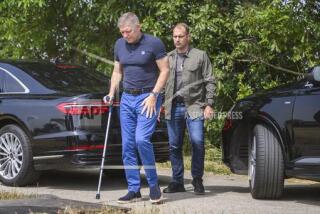After the revolution
- Share via
GIVEN his half-life as a playwright, there was only one image available to Vaclav Havel for the oddest of many odd scenes in his other half-life as a political dissident. The 1989 vote naming him president of Czechoslovakia, after his leading role in the country’s Velvet Revolution, was straight out of Alfred Jarry’s surreal classic, “Ubu Roi.” “I saw the members of parliament endorse my election in the name of every possible organization that, to this point, had been run by the state,” Havel writes, “from the Union of Women to the Czechoslovak People’s Army, I was overwhelmed by a sense of absurdity. After all, only a few days or weeks before, these same people had loudly approved my prosecution and imprisonment.”
The sudden, hapless crumbling of the communist regime is one of many topics treated in “To the Castle and Back” (the title refers to the presidential residence). It covers the 13 years of Havel’s presidency, first of Czechoslovakia and then, after Slovakia became independent, of the Czech Republic, and it continues through the first three years after he left office.
Unlike in the Soviet Union, Poland and East Germany, there was no perestroika in his country -- no gradual weakening of communist rule, no transitional stage between dictatorship and democracy. The abortive Czechoslovak transition took place back in 1968, and when the Soviet Union responded by invading, it destroyed the liberalizing forces inside the Communist Party, many of whom joined the repressed opposition. What remained in command was a demoralized hard-shell rump, ruling with a mix of force and expedience. With the Iron Curtain rusted away, the bloody revolt in Romania, the Gorbachev liberalization and the fall of the Berlin Wall, there was no external presence to sustain it. A wave of student protests, brutally dealt with, was joined by a wider opposition hastily formed into the Civic Forum, and the pragmatists in the Central Committee realized there was no way to hold on. They offered a negotiation that almost immediately turned into surrender.
Havel writes that Marian Calfa, a high Communist official, was extraordinarily helpful, advising him of possible pitfalls in the parliament and the security forces. The insurgents had achieved power but not the levers of power. Calfa, whom Havel named as interim prime minister, helped with the levers -- secretly, though, for fear of his own police agents within the Civic Forum. Thus the Jarry-like shuffle in the house of cards the Velvet Revolution brought down. This being Czechoslovakia, whose literary patron saint is satirist Jaroslav Hasek, author of “The Good Soldier Schweik” -- and this being an account by an absurdist playwright -- a few cards turn up as jokers. A persistent air of melancholy, though, runs through this oddest of quasi-memoirs, the oddity being in part the form itself. Havel has set the book out in three ways, interwoven. One is written answers to questions submitted by a journalist (and reshaped to a degree by Havel). The second is a series of memorandums he sent to his staff during his presidency. The third is a more or less conventional memoir that begins two years after he left office; he spends two months at the Library of Congress in Washington and then returns to his country.
The melancholy is, in part, frustration. As a dissident leader, Havel combined moral force (he spent five grim years in prison), shrewdness and a dramatist’s sense of form and timing to crown a long struggle with an inspiring climax. Plays end, though; life goes on. Havel refers to himself, sardonically, as a “fairy-tale prince.” It was a fairy tale, by his account, in which Rumpelstiltskin won out. The Castle became a kind of prison. Havel arrived there as a national and international hero. After 13 years, though still revered abroad, he found himself diminished at home by the democratic processes he’d helped to get going. Instead of using his popularity to form a party, he tried to stand above the parties and shape affairs by moral force.
What the politicians -- a succession of prime ministers from warring parties -- wielded was practical force. Although Havel was able to achieve some things with his limited presidential powers, his book radiates unquestionable depression, movingly and often beautifully expressed. Part of it arises from his conviction that in between the great national occasions, the Czech people tend to live up -- or down -- to their reputation for what he calls small-mindedness.
Depression notwithstanding, “To the Castle and Back” gives us any number of sharp portrayals. One of these contrasts Havel’s pacific mildness and reluctance to confront with the buzz-saw persistence of Vaclav Klaus, the conservative prime minister -- now president -- who was his chief political opponent. Havel regrets his failure to stand up to Klaus, while noting that others had the same problem: “He was simply someone who could push anything through, though often his partners agreed with him only so they wouldn’t have to go on listening to him.” A person who reveres words can find it hard to prevail against someone who uses them as weapons; on the other hand, we are reading Havel’s (lucidly translated by Paul Wilson), although it is quite certain we won’t read Klaus’.
The point of including the collection of notes he sent to his staff while he was president seems to be to show the dismaying array of occupations that holding office -- as against leading a revolution -- involves. The fairy-tale prince has to keep sewing on buttons. He will write speech after speech (How hard so much obligatory eloquence comes to a practitioner of the genuine kind!), think about NATO, cope with his prime ministers and send notes about a bat in the broom closet and the need for a longer garden hose.
Through a wretched editing oversight, the same bat and hose memorandums are scattered five times throughout. This is ruinous -- though, considering that Havel’s best-known absurdist play is “The Memorandum,” I suppose it could be seen as appropriate.
More to Read
Sign up for Essential California
The most important California stories and recommendations in your inbox every morning.
You may occasionally receive promotional content from the Los Angeles Times.










